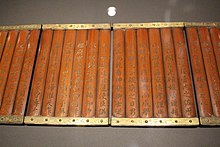Joseon Dynasty royal seals and investiture books
The collection of royal seals and investiture books of the Joseon Dynasty consists on the one hand of handcrafted seals of the kings, queens and crown princes who ruled or held office in Korea during the time of the Joseon Dynasty ( 조선 왕조 ) (1392-1910) and for Others from books documenting their inauguration and titles.
In 2017, the collection was named a World Document Heritage Site by UNESCO under the English-language title " Royal Seal and Investiture Book Collection of the Joseon Dynasty " and included in the list of the Memory of the World Register .
collection
The collection consists of a total of 669 individual pieces and covers a period from 1392 to 1966, during which the pieces were produced and used.
seal
The royal seals that make up the collection date from 1411 to 1928, when they were made. While the underside of the seal, which was used to stamp the royal emblem, always had a square shape, the handle on the upper side varied in shape and size in its representation of a turtle and was later replaced by the representation of a tiger . The seals were made either from jade or from gold , whereby the oldest seal still available consists of gold and dates back to 1437 and was used for the Crown Princess Hyeondeok ( 현덕 ) during the reign of King Sejong ( 세종 ) (1397–1450) was made.
Investment books
Royal edicts and investiture books for the crown princes and their wives were made of bamboo , while the books for kings and queens were made of jade. Golden books, on the other hand, were used during the imperial period at the end of the Joseon Dynasty, when Korea was proclaimed an empire by King Gojong ( 고종 ) in 1897 . The latest copy of the collection is the investiture book of the last empress of the Joseon dynasty, which was created when the empress Sunjeong ( 순정 ) died on February 3, 1966 as the last representative of the dynasty.
history
The royal seals and the investiture books were administered during the Joseon Dynasty by those in charge of the Jongmyo Shrine ( 종묘 ), which King Taejo ( 태조 ) (1335-1408) had built shortly after the dynasty was founded. After the Japanese Empire occupied Joseon in 1910, the Yi royal family took over the historically valuable seals and documents. After the capitulation of Japan and the associated liberation of Korea from the occupation, the property went to the former imperial household property management office, which acted as the government agency of South Korea between 1955 and 1961 . From 1962, the Office for Cultural Properties, which later became part of the Cultural Heritage Administration, took over the collection. In 1992 the company moved to a special exhibition hall in Deoksugung Palace ( 덕수궁 ) and was then moved to the Royal Exhibition Hall of Gyeongbokgung Palace ( 경복궁 ) in 2005 . In the exhibition hall, which was later renamed the National Palace Museum of Korea , the collection of the royal seals was on display in a special exhibition in November 2009.
literature
- National Palace Museum (Ed.): Royal Seal and Investiture Book Collection of the Joseon Dynasty . Seoul 2016 (English, Online [PDF; 333 kB ; accessed on November 15, 2018] Application to UNESCO for recognition of the Royal Seals and the Investiture Book Collection of the Joseon Dynasty as World Document Heritage).
Individual evidence
- ^ Royal Seal and Investiture Book Collection of the Joseon Dynasty . 2016, p. 1 ff .
- ^ A b Royal Seal and Investiture Book Collection of the Joseon Dynasty . 2016, p. 4 .
- ^ A b Royal Seal and Investiture Book Collection of the Joseon Dynasty . 2016, p. 8 .
- ^ A b Royal Seal and Investiture Book Collection of the Joseon Dynasty . 2016, p. 6 .
- ^ A b Royal Seal and Investiture Book Collection of the Joseon Dynasty . 2016, p. 5 .
- ^ About the Museum - History . National Palace Museum of Korea , accessed November 15, 2018 .




